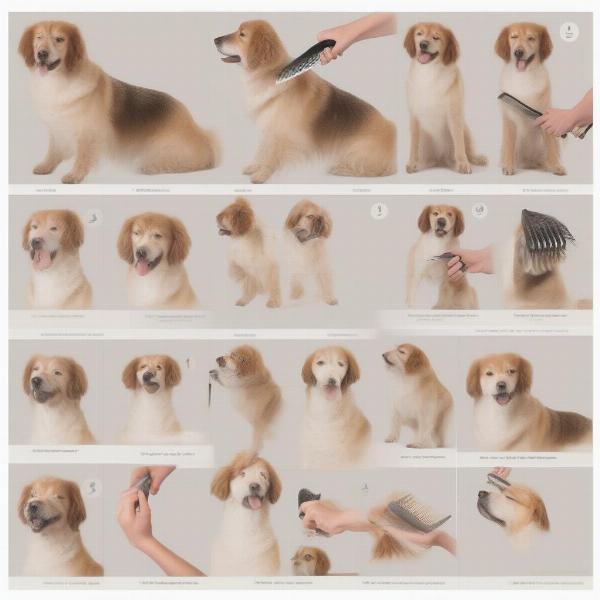A grooming comb is an essential tool for every dog owner. Whether you have a long-haired Shih Tzu or a short-coated Labrador, regular combing plays a vital role in maintaining your dog’s health, hygiene, and happiness. Using a grooming comb for dogs helps prevent matting, removes loose fur and dirt, and distributes natural oils for a healthy, shiny coat. This guide will explore the benefits of using a grooming comb, different types available, and how to choose the right one for your furry friend.
Choosing the Right Grooming Comb for Your Dog
Selecting the appropriate grooming comb can be overwhelming with the variety available. Consider your dog’s breed, coat type, and grooming needs.
Understanding Different Comb Types
- Double-sided combs: These combs offer versatility with two different tooth spacings. One side typically has wider teeth for detangling, while the other has finer teeth for removing fleas and debris.
- Undercoat rakes: Designed for dogs with thick double coats, these combs effectively remove loose undercoat hair, minimizing shedding and preventing mats.
- Flea combs: With closely spaced fine teeth, flea combs are essential for detecting and removing fleas and their eggs.
- Metal combs: Durable and long-lasting, metal combs are suitable for various coat types and can handle tough mats. However, be cautious with excessive pressure, as they can irritate the skin.
- Plastic combs: Lighter and more affordable than metal combs, plastic options are gentle on the skin and ideal for sensitive dogs.
Matching Comb to Coat Type
- Short-coated dogs: A fine-toothed comb or a rubber curry brush is sufficient for removing loose hair and distributing skin oils.
- Medium-coated dogs: A slicker brush followed by a medium-toothed comb helps prevent mats and removes tangles.
- Long-coated dogs: A combination of a slicker brush, an undercoat rake, and a wide-toothed comb is essential for maintaining a healthy, mat-free coat.
Benefits of Using a Grooming Comb for Dogs
Regular combing offers numerous benefits beyond just a shiny coat.
Health Benefits
- Reduces shedding: Combing removes loose hair, minimizing shedding around your home.
- Prevents matting: Regular combing prevents painful mats and tangles, especially in long-haired breeds.
- Distributes natural oils: Combing helps distribute the skin’s natural oils, promoting a healthy and shiny coat.
- Early detection of skin issues: Combing allows you to check for fleas, ticks, skin irritations, or other abnormalities early on.
Behavioral Benefits
- Bonding experience: Grooming is a great way to bond with your dog and build trust.
- Reduces stress and anxiety: The rhythmic motion of combing can have a calming and relaxing effect on dogs.
- Improved socialization: Regular grooming helps desensitize dogs to being touched, making veterinary visits and other handling situations easier.
How to Use a Grooming Comb Effectively
Proper technique ensures a comfortable and effective grooming session.
Step-by-Step Guide
- Start with a brush: If your dog has a long or thick coat, use a slicker brush to remove loose hair and tangles before combing.
- Choose the right comb: Select the appropriate comb for your dog’s coat type.
- Comb in the direction of hair growth: Gently comb from the head to the tail, working in sections.
- Be gentle around sensitive areas: Use extra care around the face, ears, and belly.
- Reward your dog: Offer praise and treats throughout the grooming session to make it a positive experience.
 Using a Grooming Comb Effectively
Using a Grooming Comb Effectively
Conclusion
Investing in a grooming comb for dogs is an investment in their overall well-being. From preventing mats and reducing shedding to strengthening your bond, regular combing offers numerous benefits. By understanding the different types of combs available and following proper grooming techniques, you can ensure your furry friend enjoys a healthy, shiny, and comfortable coat. Remember to choose the right comb for your dog’s breed and coat type, and make grooming a positive and rewarding experience for both of you.
FAQ
- How often should I comb my dog? The frequency depends on your dog’s breed and coat type. Long-haired dogs may require daily combing, while short-haired dogs may only need weekly combing.
- Can I use a human comb on my dog? It’s best to use combs specifically designed for dogs, as human combs can be too harsh and may damage their coat.
- What should I do if my dog’s coat is severely matted? Consult a professional groomer to safely remove severe matting.
- How do I clean my dog’s grooming comb? Wash the comb with warm, soapy water after each use and allow it to dry completely.
- What are the signs of skin irritation from combing? Redness, itching, and excessive scratching can indicate skin irritation.
Related Articles:
About ILM Dog:
ILM Dog is your trusted resource for all things dog-related. We provide expert advice on dog breeds, health, training, nutrition, grooming, and more. Our mission is to empower dog owners worldwide with the knowledge and resources they need to provide their furry companions with the best possible care. From choosing the right breed to providing expert grooming tips like selecting the best grooming comb for dogs, ILM Dog is your comprehensive guide to canine companionship. Contact us at [email protected] or +44 20-3965-8624 for personalized guidance.